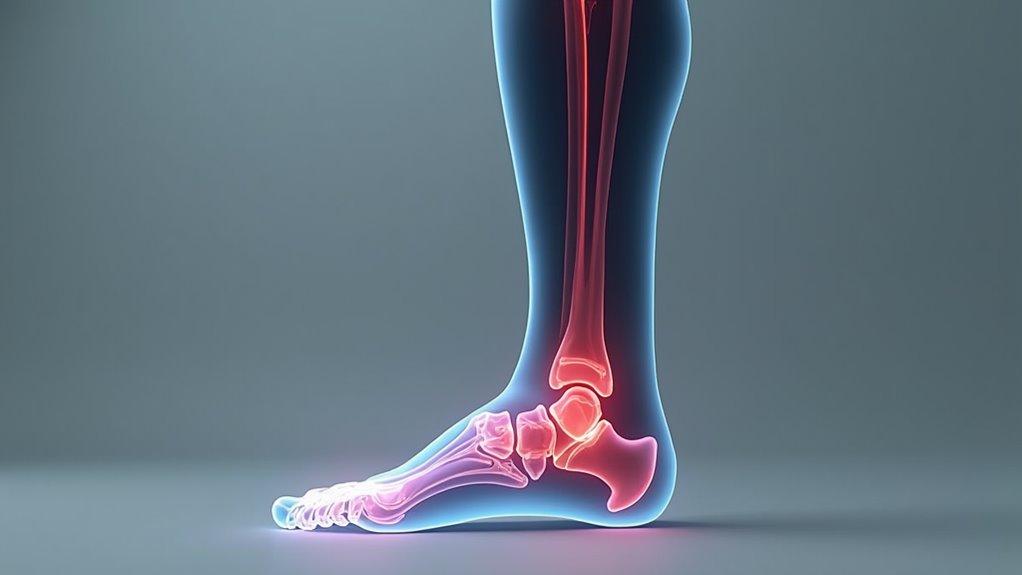There may be products. Products are independently selected by our editors. We may earn an affiliate commission from the links with no charge to you, example: as Amazon Affiliate.
Your heel’s position during each step triggers a complex chain reaction that affects every joint above it, yet most people don’t realize they’re walking with misaligned heels until pain develops. When you roll your foot inward or outward while standing and walking, you’re actually creating subtle shifts in your knee and hip mechanics that can lead to long-term structural issues. While occasional discomfort might seem minor, these alignment problems often compound over time, potentially leading to chronic conditions that could’ve been prevented with early intervention. Understanding the warning signs can help you take control of your joint health before serious problems develop.
Key Takeaways
- Heel position directly influences knee and hip alignment through a kinetic chain, affecting how weight distributes through the lower limbs.
- Overpronation and flat feet can cause inward knee rotation, while high arches lead to outward rotation and misalignment.
- Custom orthotics and proper footwear support natural foot alignment, reducing strain on knees and hips during daily activities.
- Strong ankle and foot muscles maintain proper heel alignment, preventing tracking problems and compensatory movement patterns.
- Daily activities and repetitive movements can create misalignments, requiring proper form and supportive footwear to maintain joint health.
The Heel Connection
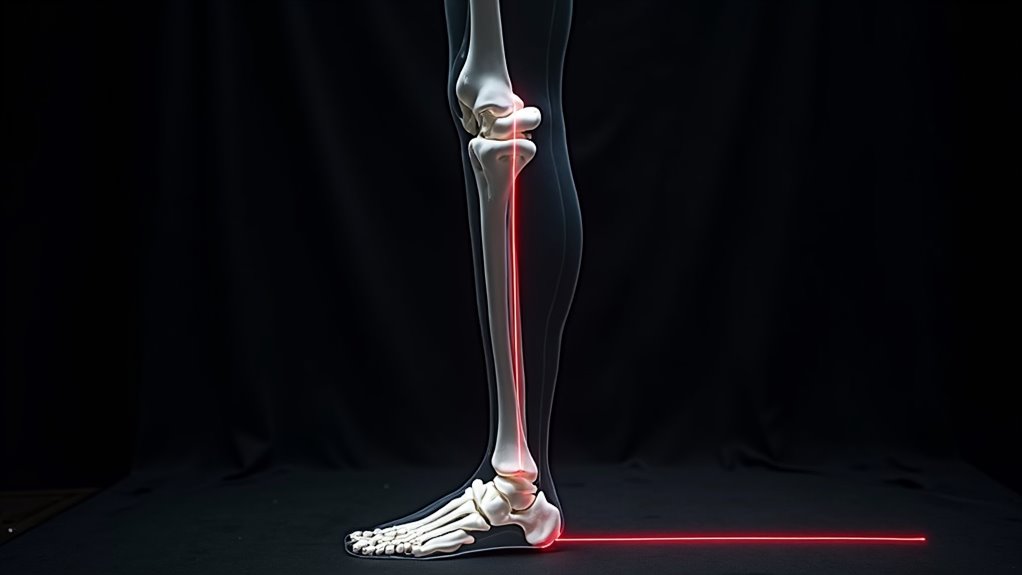
When it comes to knee and hip health, your heel plays a pivotal role in maintaining proper alignment throughout your lower body. Your heel’s position directly influences how your knee tracks and functions during movement.
If you’re experiencing overpronation, where your foot rolls inward excessively, you’ll notice your lower and upper leg rotating inward, creating a knock-kneed position.
You’ll want to focus on strengthening the muscles around your foot and ankle while ensuring your heel maintains a neutral alignment. This helps prevent tracking problems and reduces stress on your knee joint.
You can achieve better alignment through targeted exercises, proper stretching of tight calf muscles, and sometimes with the help of orthotics that provide arch support and shock absorption. Consider using posture support heels to help maintain optimal alignment throughout your daily activities.
Common Heel Alignment Problems
Four major heel alignment problems can significantly impact your lower body mechanics: overpronation, flat feet, bunions, and hammertoes. When your ankle’s talus bone slips forward, it creates a chain reaction throughout your foot structure, leading to these conditions. Over 45% of people suffer from foot misalignment, which can compromise your foot’s natural cushioning ability. Many women seeking stylish footwear can find comfort-focused heel options that provide better support and alignment.
Common symptoms you might experience include:
- Collapsed arches due to misalignment forcing the sinus tarsi space to narrow
- Painful bumps at the base of your big toe from bunion formation
- Curled or bent toes resulting from foot instability
These issues don’t just affect your feet – they can radiate up through your legs, causing knee, hip, and lower back pain.
Early detection and proper treatment, whether through custom orthotics or minimally invasive procedures, can prevent further complications.
Impact on Knee Health
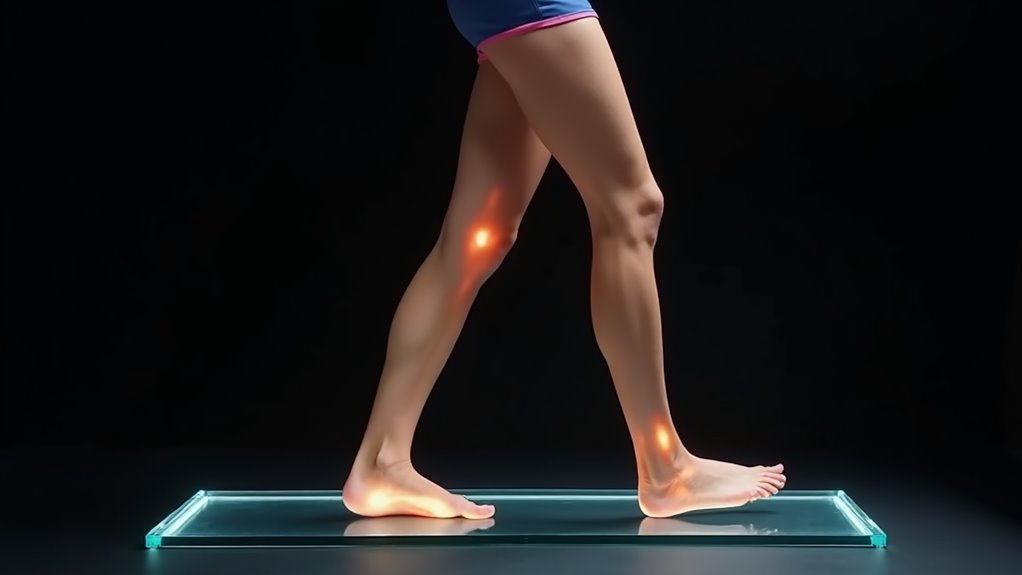
Your heel alignment directly impacts your knee health through a complex chain of biomechanical relationships. When your feet aren’t properly aligned, you’ll experience stress throughout your lower body, particularly in your knees. You’ll notice this most commonly through overpronation (flat feet) or supination (high arches).
| Foot Type | Impact on Knees | Solution |
|---|---|---|
| Flat Feet | Inward knee rotation, inner knee pain | Custom orthotics |
| High Arches | Outward knee rotation, poor shock absorption | Cushioned inserts |
| Normal but Misaligned | Uneven pressure distribution | Proper footwear |
| Irregular Gait | Asymmetrical knee stress | Gait analysis |
Your choice of footwear plays a crucial role in maintaining proper alignment. High heels and shoes lacking support can force your knees to work harder, while supportive shoes with strong midsoles help prevent strain and reduce injury risk. For optimal foot health and alignment, consider using foot care products recommended by podiatrists to address specific conditions.
Hip Stability Factors
Moving up from the knee joint, hip stability forms the foundation of proper lower body alignment. Your hip’s stability relies on both structural and dynamic factors working together. The acetabulum’s depth and labrum create a secure socket for your femoral head, while soft tissues like ligaments and muscles provide crucial support.
- The iliofemoral, pubofemoral, and ischiofemoral ligaments work with your joint capsule to maintain stability.
- Your gluteus medius and other abductor muscles actively resist femoral head rotation during movement.
- The iliotibial band functions as a tension band, reducing the workload on your gluteus medius.
When you’re standing on one leg, your body’s center of gravity shifts, and your muscles must compensate to maintain stability.
Understanding these mechanisms helps you address alignment issues and prevent potential problems. For extended periods of standing, wearing cushioned formal shoes can help maintain proper hip alignment and reduce stress on supporting muscles.
Corrective Exercises and Stretches
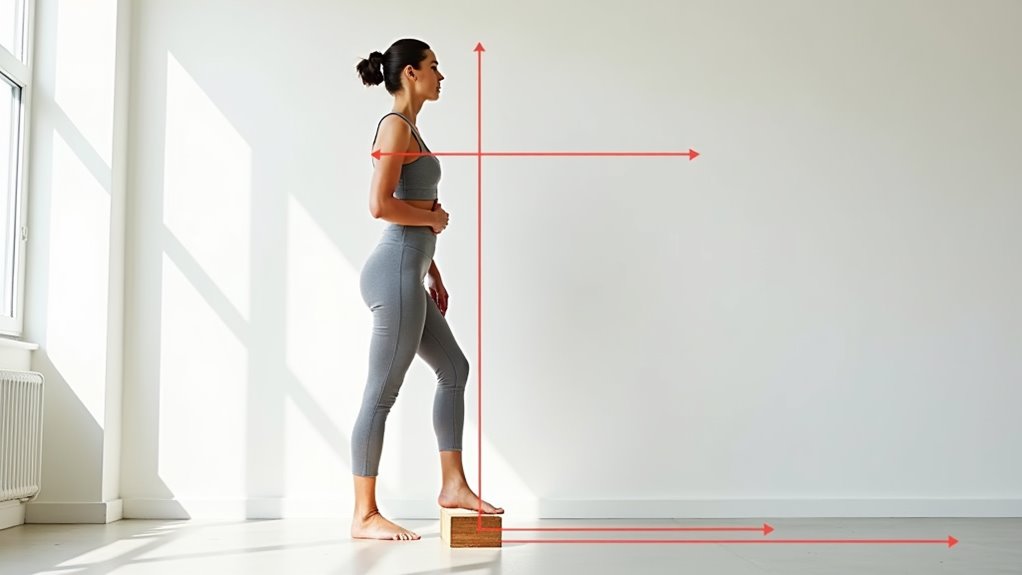
To address heel-related alignment issues, a targeted program of corrective exercises and stretches can strengthen key muscle groups while improving flexibility.
You’ll want to start with heel slides while lying on your back, sliding your affected leg toward your buttocks and holding for 5 seconds. Next, focus on knee strengthening by performing seated leg raises and standing knee bends.
For hip mobility, you can perform various stretches including seated forward bends, lunges with overhead reaches, and band-assisted leg movements.
Don’t forget to integrate core exercises like reverse lunges with twists and side step-ups to enhance overall stability.
Include clamshells and straight leg raises to engage your hip abductors and strengthen your hamstrings, ensuring proper alignment throughout the kinetic chain.
Wearing shoes with comfort technology heels can provide additional support while performing these corrective exercises and stretches.
Footwear and Support Options
When choosing athletic shoes to support your knee and hip alignment, look for models with rocker soles, ankle-high support, and adjustable features that ensure a customized fit.
You’ll find excellent options in brands like Hoka, Saucony Endorphin, and The North Face vActive Range, which combine stability features with comfortable designs.
Custom orthotics can enhance your footwear’s effectiveness by correcting foot positioning, redistributing pressure, and improving overall lower limb alignment to reduce strain on your knees and hips.
For formal occasions requiring elevated footwear, select neutral-colored heels that provide adequate arch support and stability while complementing any outfit.
Proper Athletic Shoe Selection
Selecting the right athletic footwear plays a crucial role in maintaining proper knee and hip alignment.
You’ll need to consider your foot type and gait pattern to choose shoes that provide appropriate support and cushioning. Understanding your arch type – whether high, normal, or flat – will help determine the level of support you need for optimal alignment.
- Choose shoes with the correct heel drop based on your running style – high drop (8-12mm) for heel strikers, mid drop (5-8mm) for beginners, and low drop (1-4mm) for those seeking a more natural stride.
- Ensure proper cushioning that matches your foot type, with extra padding for high arches and stabilizing features for flat feet.
- Select sport-specific designs that account for the unique movements and impacts of your chosen activity.
Custom Orthotics Benefits
Custom orthotics represent a powerful solution for individuals seeking personalized foot support and pain relief. They’ll redistribute pressure across your feet while correcting alignment issues that affect your knees, hips, and lower back.
You’ll benefit from shock absorption that makes walking and standing more comfortable. These tailored inserts can help you overcome specific conditions like plantar fasciitis, heel spurs, and bunions by providing targeted support where you need it most.
You’ll notice improved stability and posture as the orthotics align your body from feet to spine. With custom-fitted support, you can maintain an active lifestyle with reduced risk of injury and less fatigue.
Whether you’re an athlete or someone who stands all day, you’ll find that custom orthotics offer long-term benefits for mobility and pain management.
Daily Movement Patterns
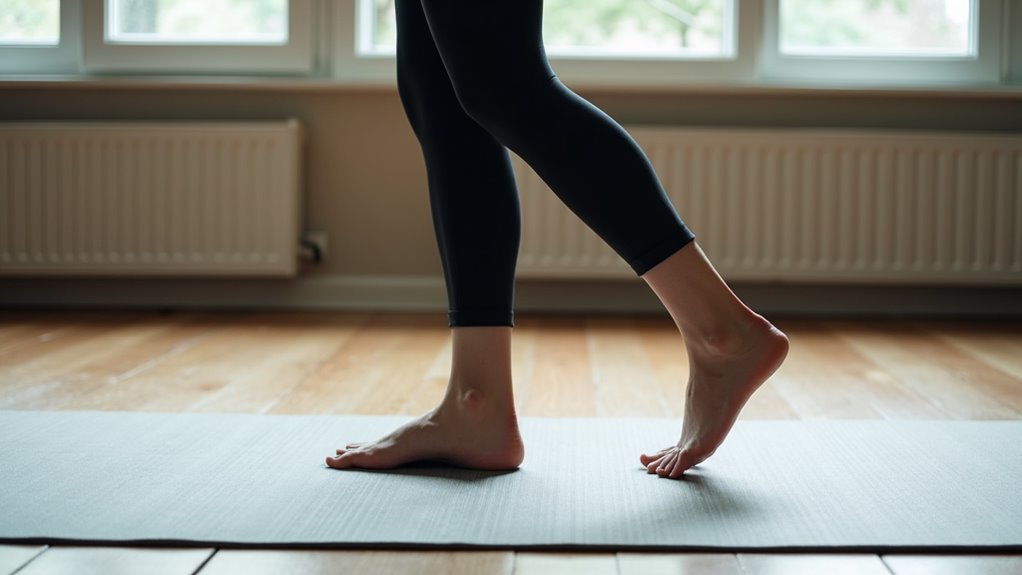
Your daily movements, from walking and running to climbing stairs, create specific loading patterns that directly affect how your knees and hips absorb impact forces through your heels.
When you navigate different terrains, your body naturally adjusts its mechanics, which can either support or challenge proper alignment between your heels, knees, and hips.
Through repetitive motions, your body may develop compensatory patterns to deal with misalignments, potentially leading to stress on your joints and surrounding tissues.
Loading and Landing Mechanics
Three fundamental aspects govern proper loading and landing mechanics: alignment, muscle engagement, and force absorption.
You’ll need to maintain proper knee-toe alignment and a neutral spine while engaging your core muscles to protect your joints during landing. Your gluteal muscles, hip flexors, and quadriceps work together to control descent and stabilize your body.
Key components for effective landing include:
- Landing softly on the balls of your feet while maintaining adequate ankle dorsiflexion
- Using your posterior chain muscles by shifting your weight back while keeping shoulders, hips, and knees stacked
- Balancing hip and knee strategies to prevent compensatory motions that can lead to joint stress
Movement Through Terrain
While navigating different terrains in daily life, your body relies on fundamental movement patterns that include squatting, hip hinging, lunging, pushing, pulling, and locomotion.
Your ability to move efficiently depends on proper hip mechanics and gait patterns, which require single-leg strength and core stability.
Your ankle joint’s mobility through dorsiflexion, plantar flexion, and eversion/inversion helps you maintain balance on uneven surfaces.
You’ll need strong hips to reduce knee pain and improve movement quality. When you’re carrying loads, your core strength becomes essential for maintaining proper form and supporting all foundational movements.
To enhance your movement capabilities, you should focus on smooth transitions between patterns while maintaining proper force distribution into the ground.
Your upper body leads directional changes, ensuring you move efficiently through various terrains.
Repetitive Motion Compensation
Each day, repetitive movements create subtle compensations in your body as it adapts to joint or muscle dysfunctions.
These altered movement patterns can affect your entire kinetic chain, from ankles to hips, leading to inefficient biomechanics and increased tissue stress.
When you’re experiencing limited range of motion, your body naturally finds alternative ways to move, often resulting in overworked muscles and potential injury.
- Your ankles’ dorsiflexion and plantar flexion limitations can force your knees and hips to rotate inappropriately.
- Your posterior tibialis muscle weakens from prolonged standing on hard surfaces, causing arch collapse.
- Your wrist and elbow movements can trigger compensatory patterns in your shoulders and spine.
Understanding these patterns is crucial for preventing chronic pain and maintaining proper alignment through daily activities.
Prevention and Maintenance Strategies
Maintaining proper knee and hip alignment requires a comprehensive approach that combines targeted exercise programs with biomechanical awareness.
You’ll need to incorporate multiple training types, including strength, plyometric, and core conditioning exercises, for at least 20 minutes several times weekly. Focus on strengthening your quadriceps, hamstrings, glutes, and calf muscles while improving flexibility around your knee joint.
Pay special attention to your ankle mobility, as restricted dorsiflexion can affect knee alignment. Consider using heel lifts to reduce medial knee displacement and work on hip adductor activation.
Your prevention routine should include sport-specific training for over 30 minutes multiple times per week. Programs like 11+, FIFA, or Knäkontroll can help you maintain proper alignment and reduce injury risk through structured exercise routines.
For personalized support during exercise and daily activities, comfort solutions can provide additional stability and proper positioning for your joints.
Conclusion
Your heel alignment plays a crucial role in maintaining healthy knees and hips. With studies showing that 70% of people with improper heel alignment experience knee pain within five years, it’s essential to take proactive steps. You’ll benefit from regular stretching, proper footwear, and professional guidance when needed. Don’t wait for pain to develop – start implementing these alignment strategies into your daily routine today.

